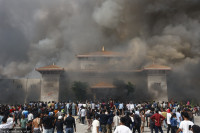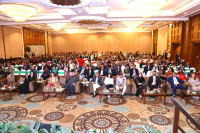Valley
Nepal-China transit talks today
Officials from Nepal and China are meeting in Kathmandu on Wednesday and Thursday to finalise the text of Protocol to Nepal-China Transit and Transportation. This is the third senior official-level meeting after Prime Minister KP Oli signed the landmark Transit and Transportation Agreement during his first premiership in 2016.
Officials from Nepal and China are meeting in Kathmandu on Wednesday and Thursday to finalise the text of Protocol to Nepal-China Transit and Transportation. This is the third senior official-level meeting after Prime Minister KP Oli signed the landmark Transit and Transportation Agreement during his first premiership in 2016.
Officials have to identify and agree on sea routes, basically to be used by Nepali businessmen, before signing the transit protocol.
“We will begin talks from the point we had left off in the last meeting in Beijing,” said Rabi Shankar Saiju, joint secretary at the Ministry of Commerce and the leader of the Nepali delegation. The Nepali team has representatives from foreign, law, physical planning and transportation ministries.
Wang Shuiping, director general at the Department of Transport Services, who arrived here on Monday is leading a nine-member Chinese delegation.
On Tuesday, the Nepali and Chinese teams carried out the field visits of Kurintar in Chitwan where the proposed Nepal-China rail is expected to cross as well as a new north-south corridor is built. They examined the road condition and geography of the area.
During the second round of talks in Beijing , the Nepali side made a visit to Tianjin sea port and inspected the facilities there. The two sides made little headway during the talks held on July 10 and 11, with some technical issues acting as a roadblock. Nepal and China have separate texts on the protocol-related matters and they have to agree on a single report, a Nepali official said requesting anonimity. “We hope to have some breakthrough this time,” the official added.
Nepal is looking for two land ports and three sea ports with China for third country trading, according to the
officials.
“There is not much dispute on using Chinese land ports, but there are disagreements on using the sea port and their routes,” said the official.
Specification of the sea routes is the major bone of contention between the two sides. The Chinese side wants to allow Nepal to use its sea ports without providing any specific sea routes, while the Nepali side has been pressing for specific routes. Nepal has proposed to use Tianjin, Shanghai and Guangzhou seas ports.
In the backdrop of Indian blockade, PM Oli signed the Transit and Transportation Agreement with China to end Nepal’s long-standing dependency on Indian sea ports and using transit facilities for third country trade.




 8.12°C Kathmandu
8.12°C Kathmandu









